Archive:Agriculture statistics - the evolution of farm holdings
This articles has been archived. For more detailed information see other articles on agriculture.
This article is part of a set of statistical articles that together form Eurostat’s statistical book on Agriculture, forestry and fishery statistics. The latest agricultural census in the European Union (EU) was conducted for the 2009 or 2010 reference years. This article presents results for a selection of indicators, comparing the situation in 2010 with earlier years, in particular, 2005 when a farm structure survey (FSS) was conducted. The article focuses on the change in the number and relative importance of agricultural holdings — referred to hereafter as farms — of various size categories; their size is determined either by a physical characteristic (the utilised agricultural area (UAA)) or an economic measure (the standard output).
It should be noted that some methodological and legislative changes occurred between the 2005 and 2010 surveys: in the Czech Republic, Germany, Poland, Slovakia and the United Kingdom there was a reduction in the coverage of the survey that resulted from an increase in the minimum size threshold of farms. By contrast, in Italy, where thresholds are determined at a regional level, the overall impact of the change in thresholds was to increase the size of the surveyed population. These changes impact not just on the data for these EU Member States but also on the aggregated data for EU aggregates (such as EU-27 or EU-28). The impact of these changes is greatest on the data for those size classes which regroup smaller farms.

- Source: Eurostat (ef_kvaareg)

(% share of total) - Source: Eurostat (ef_kvaareg)

(%) - Source: Eurostat (ef_kvaareg)
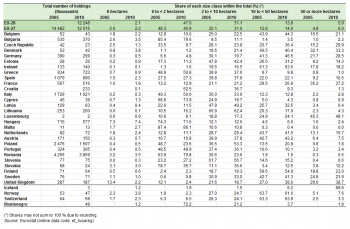
- Source: Eurostat (ef_kvaareg)

- Source: Eurostat (ef_kvaareg)
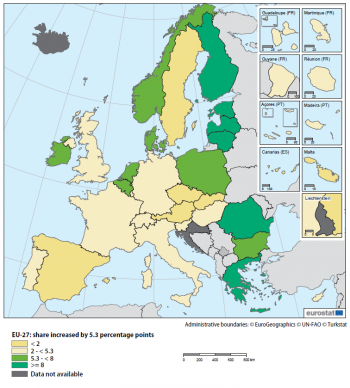
(percentage points) - Source: Eurostat (ef_kvaareg)

- Source: Eurostat (ef_kvaareg)

(percentage points) - Source: Eurostat (ef_kvaareg)
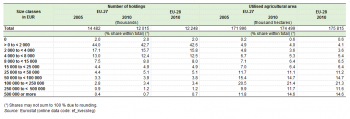
- Source: Eurostat (ef_kvecsleg)
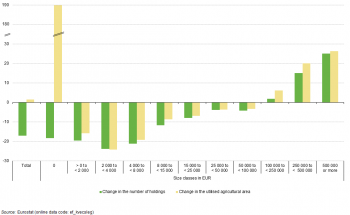
(%) - Source: Eurostat (ef_kvecsleg)
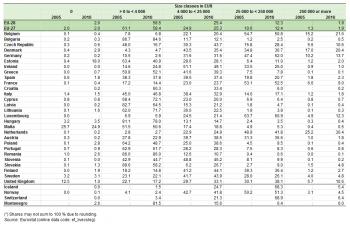
(% share of each size class within the total) - Source: Eurostat (ef_kvecsleg)
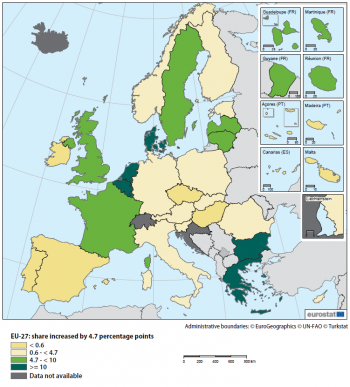
(percentage points) - Source: Eurostat (ef_kvecsleg)
Main statistical findings
Analysis of farms according to farm size in terms of area
The first part of this article focuses on a size class analysis of farms based on their utilised agricultural area. It should be noted that this indicator does not include land occupied by buildings or farmyards and that some farms may not have any utilised agricultural area if they only rear livestock in animal housing (for example, poultry farms).
In 2010, there were 12.2 million farms in the EU-28: collectively their utilised agricultural area encompassed 176 million hectares (ha), or 1.76 million km². The land used by farms in the EU-28 accounted for approximately 40 % of the total land area.
The structure of farming in the EU was made up of two contrasting types of farm: on the one hand, the vast majority of farms cultivated a relatively small area, and on the other, there were a small number of farms that cultivated much larger areas.
Around four fifths (80.3 %) of all farms in the EU-28 had less than 10 hectares of utilised agricultural area, and together these smaller farms cultivated some 12.2 % of the utilised agricultural area. By contrast, only 5.9 % of the farms in the EU-28 cultivated 50 hectares or more of land for agricultural purposes, however, these larger farms collectively cultivated two thirds (66.6 %) of the total utilised agricultural area. Table 1 shows that between these two extremes, EU-28 farms with 10 or more hectares but less than 20 hectares of utilised agricultural area accounted for broadly similar shares of the number of farms (7.5 % of the total) and the utilised agricultural area (7.3 % of the total).
The average farm size in the EU-27 rose from 11.9 hectares to 14.5 hectares between 2005 and 2010; the largest farms grew most
An analysis of farms between 2005 and 2010 is available for the EU-27 (in other words for the EU-28 without Croatia), although it should be noted that the coverage of the surveys changed between 2005 and 2010 in several Member States (see Data sources and availability for more information). Between 2005 and 2010, the overall number of farms in the EU-27 fell by 17.0 % while their utilised agricultural area increased by 1.5 %. As a consequence the average size of each farm rose from 11.9 hectares in 2005 to 14.5 hectares in 2010. Among the largest farms, those with 100 hectares or more of utilised agricultural area, the average farm size grew from 265 hectares per farm in 2005 to 273 hectares per farm in 2010.
The share of agricultural area cultivated by smaller farms fell and that of larger farms grew
Figure 1 shows the distribution of farms and their utilised agricultural area by size class, comparing the EU-27 data for 2005 and 2010. Over this period, farms with 100 hectares or more of utilised agricultural area were the only size class to record an increase in their share of the total land area that was cultivated for agricultural purposes in the EU-27.
The share of the total number of farms in the EU-27 accounted for by farms with no utilised agricultural area increased slightly between 2005 and 2010. By contrast, the shares for the next two smallest size classes, covering farms with more than zero hectares but less than five hectares, both fell between 2005 and 2010. The share of the total number of farms accounted for by farms with five or more hectares but less than 10 hectares was unchanged in 2010 compared with 2005, while the share for each of the larger size classes increased.
The increase in the utilised agricultural area of farms with at least 100 hectares outweighed the decrease in the utilised agricultural area of all other farms
Figure 2 shows the percentage change in the number of agricultural holdings and their utilised agricultural area by size class between 2005 and 2010 in the EU-27; these changes reflect not just the developments in the shares between the different size classes but also the overall change in the number of farms and the total utilised agricultural area. As can clearly be seen, the only size class that recorded increases for its number of farms and utilised agricultural area was the class covering farms with 100 hectares or more. Given that the overall utilised agricultural area was higher in 2010 than in 2005, this confirms that the increase in the utilised agricultural area of farms with 100 hectares or more was larger than the combined decrease in the utilised agricultural area of farms in all other size classes. The largest decreases were generally recorded for the smallest size classes, but it should be noted that these are the classes most likely to be influenced by changes in survey thresholds.
Between 2000 and 2010 the largest farms (with 100 hectares or more) in the EU-15 increased in number and average size (area), while the overall number of farms fell
Looking over a longer period of time, namely between the agricultural census results for 2000 and 2010, developments can be analysed for the EU-15 (the group of 15 Member States before the successive enlargements of 2004, 2007 and 2013). Between 2000 and 2010 the total number of farms in the EU-15 fell by just over one fifth (-22.8 %), while the total utilised agricultural area was relatively unchanged (-0.5 %); as a result, the average size of farms increased, on average, by 5.4 hectares per farm to reach 24.1 hectares per farm.
The structural changes, in terms of the shares of each size class, were quite profound, particularly in terms of the utilised agricultural area. The share of the total number of farms in the EU-15 that had 100 hectares or more of utilised agricultural area increased by 2.1 %, whereas their share of the total utilised agricultural area increased by 36.1 %. The average size of these largest farms in the EU-15 increased from 233 hectares per farm in 2000 to 251 hectares per farm in 2010. Not only did their share in the total number of farms increase, but their number also increased in absolute terms: there were 26.2 % more farms with 100 hectares or more of utilised agricultural area in 2010 than in 2000 and their combined utilised agricultural area increased by 35.9 %.
Among the EU Member States the number of farms increased between 2005 and 2010 only in Ireland and Malta
A similar analysis for each of the EU Member States is presented in Tables 2 and 3. Overall, Ireland and Malta stand out as the only EU Member States where the number of farms and the utilised agricultural area was higher in 2010 than in 2005. A fall in the number of holdings and in the utilised agricultural area was reported by 14 of the Member States. The remaining 11 Member States (no comparison available for Croatia) reported a similar situation to that observed for the EU-27 as a whole, namely, an increase in utilised agricultural area but a decline in the overall number of farms. Among those Member States where the utilised agricultural area was lower in 2010 than in 2005, the largest decreases, in terms of hectares, were reported by Spain, Romania, Austria, Germany and Poland, whereas the largest percentage falls were recorded by Cyprus (-21.8 %) and Austria (-11.9 %).
The increase in the relative importance of larger farms (50 hectares or more) was almost universal among the EU Member States
Concerning changes in structure, nearly all of the EU Member States recorded an increase between 2005 and 2010 in the share of larger farms (those with 50 hectares or more of utilised agricultural area). Sweden was one exception as the share of these larger farms in the total number of farms fell slightly. Malta was another exception as there were no farms of this size, although the share of farms in the size class of 10 to less than 50 hectares (the largest size class in which there were farms in Malta) recorded an increase.
The share of utilised agricultural area cultivated by these larger farms (with 50 hectares or more of utilised agricultural area) also increased in nearly every EU Member State. Map 1 illustrates how the relative importance of these larger farms changed between 2005 and 2010. Overall, in the EU-27, the share of utilised agricultural area cultivated by larger farms increased by 5.3 percentage points between 2005 and 2010, to reach 66.9 % of the total land that was cultivated. Those Member States where the share of larger farms increased by at least 8.0 percentage points between 2005 and 2010 included the Baltic Member States (Estonia, Latvia and Lithuania), Finland, Romania and Greece. By contrast, in Austria and Slovakia the larger farms’ share of utilised agricultural area fell, while in Malta, the Czech Republic, Spain and Sweden, the increase in their share was less than 2.0 percentage points.
The average number of animals per farm increased in the EU-27 from 9.5 livestock units in 2005 to 11.2 livestock units in 2010
Across the whole of the EU-28 there were 135 million farm animals in terms of livestock units (LSUs) in 2010 (see Table 4), an average of 11.0 livestock units per farm. Nearly half (49.1 %) of these animals (measured in livestock units) were reared by larger farms with 50 hectares or more of utilised agricultural area, while smaller farms (with less than 10 hectares of utilised agricultural area) accounted for close to one quarter (24.0 %) of the total.
Data for the EU-27 show that the overall number of animals (in livestock units) decreased 2.2 % between 2005 and 2010. Because this fall was smaller than the equivalent fall in the number of farms, the average number of animals per farm increased from 9.5 livestock units in 2005 to 11.2 livestock units in 2010.
The shares of livestock in the farms with zero hectares of utilised agricultural area increased substantially
The distribution of these animals across farms of different sizes changed between 2005 and 2010. Most notable were the increased shares for the very smallest and the very largest farms: the share of animals (in livestock units) reared on farms in the EU-27 with no utilised agricultural area increased by 2.3 percentage points to 9.1 % of the total, while the share of animals reared on farms with at least 100 hectares of utilised agricultural area increased by 3.7 percentage points to 29.4 % of the total. The share for the next largest size class (50 to less than 100 hectares) was unchanged, whereas the livestock share of all other size classes fell between 2005 and 2010.
Farms with less than 10 hectares of utilised agricultural area occupied more than half of the labour force
In 2010, the directly employed labour force in agriculture was 9.9 million annual work units. The directly employed labour force includes farm holders and working members of their family as well as workers employed directly by the farm, regardless of whether they work regularly or not. A work unit corresponds to the work performed by one person who is occupied on a farm on a full-time basis. It should be noted that many farmers and farm workers pursue agriculture as a part-time activity and agriculture is characterised by seasonal labour peaks, where large numbers of workers may be hired for a relatively short period of time. This can be seen from the average size of the labour force per farm, which was 0.81 annual work units in the EU-28 in 2010.
Whereas farms with at least 50 hectares cultivated two thirds of the overall utilised agricultural area and reared half of the livestock in the EU-28, they occupied just under one fifth (19.1 %) of the directly employed labour force. Smaller farms, with less than 10 hectares of utilised agricultural area, occupied more than half (57.6 %) of the labour force.
The share of the labour force fell in the size classes of farms with less than 10 hectares of utilised agricultural area while it increased in all other size classes
Between 2005 and 2010 the average size of EU-27 farms (in terms of their labour force) fell from 0.88 annual work units to 0.81 annual work units, with a 23.2 % contraction in labour input which fell from 12.7 million annual work units to 9.8 million annual work units. The share of the labour force in farms with no utilised agricultural area increased in the EU-27 by 0.3 percentage points to 1.8 % in 2010. Apart from this size class, there was a general pattern between 2005 and 2010 that the share of the labour force fell for those farms with less than 10 hectares of utilised agricultural area while it increased in all other size classes.
In percentage point terms, the largest reduction in labour input (-3.4 percentage points) was registered for the smallest size class (farms with more than zero but less than two hectares). As the average size of farms got progressively larger, their share of the total labour force increased between 2005 and 2010. This was the case for farms with 10 to less than 20 hectares, and this pattern became even more apparent among much larger farms. Indeed, the share of the EU-27’s agricultural labour that was accounted for by farms with 100 hectares or more increased by 2.5 percentage points over the period 2005–10.
The change between 2005 and 2010 in the relative importance of larger farms (with 50 hectares or more of utilised agricultural area) in terms of their share of the total agricultural labour force can be seen in Map 2. Across the EU-27, the labour force share of these larger farms increased by 3.8 percentage points to reach 19.3 % in 2010. Those EU Member States where the share of larger farms rose by at least 7.0 percentage points between 2005 and 2010 included Slovakia, the Baltic Member States, Finland, the United Kingdom and Germany. In none of the EU Member States did the share of the labour force employed by larger farms decline. The smallest increases were recorded in Ireland, Greece, Portugal, France and Hungary; there were no farms of this size in Malta.
Analysis of farms according to size in terms of output
The second part of this article continues with the analysis of farms by size, but using size classes based on the value of their standard output: coefficients are calculated as the average monetary value of the agricultural output at farm-gate price, in euro per hectare or per head of livestock; these coefficients are calculated at a regional level for each product. The standard output of each farm can be calculated combining the coefficients with information on how many hectares of different types of crops it has and how many head of different types of livestock.
As can be seen from Table 5, in the EU-28 in 2010 each of the size classes of farms with less than EUR 15 000 of standard output had higher shares of the number of farms than their shares of utilised agricultural area. By contrast, for each of the size classes of farms with EUR 15 000 or more of standard output the reverse was true, indicating that these farms were generally larger in terms of utilised agricultural area.
The very largest farms, with a standard output of EUR 0.5 million or more, cultivated 14.6 % of the total utilised agricultural area in the EU-28, but this size class accounted for only 0.7 % of the total number of farms. Combining several of the larger size classes, while only one in five (19.1 %) farms across the EU-28 had a standard output of EUR 15 000 or more, these farms cultivated four fifths (79.8 %) of the utilised agricultural area. By contrast, more than two fifths (44.6 %) of farms in the EU-28 had a standard output of less than EUR 2 000 and these farms accounted for just one twentieth (4.6 %) of the total utilised agricultural area.
The increase in the utilised agricultural area of farms with at least EUR 100 000 of standard output outweighed the decrease of all other farms
As noted earlier, the comparison of data for 2005 and 2010 for the EU-27 is influenced to some extent by changes in the coverage of the surveys. Figure 3 focuses on the percentage changes in the number of farms in the EU-27 and their utilised agricultural area between 2005 and 2010, with an analysis by standard output size class; this figure can be compared with Figure 2 which presented a similar analysis based on size classes of the utilised agricultural area. The overall pattern is broadly similar, with growth in the number of farms and the utilised agricultural area reported by the largest size classes — in this case all classes where standard output was at least EUR 100 000 — and with a fall in the number of farms and utilised agricultural area for nearly all of the smaller size classes. The largest decreases were generally recorded for the smallest size classes, but it should be noted that these are the classes most likely to be influenced by changes in survey thresholds. The one major difference between this analysis using the standard output and that based on the utilised agricultural area is the large increase in the utilised agricultural area of farms in the size class with EUR 0 standard output: the quarter of a million farms in this size class cultivated 0.6 % of the utilised agricultural area in the EU-27 in 2010 having held a share of just 0.2 % in 2005. The category of farms with no standard output includes farms with fallow land, permanent grassland and meadow that is not used for production, and kitchen gardens.
An analysis for each of the EU Member States (see Table 6) indicates that the increase in the share of the number of farms in the largest size classes (in this case farms with a standard output of EUR 250 000 or more) was widespread, with only Cyprus recording a fall in their share between 2005 and 2010, although there was no change in the share in Greece. In percentage point terms, the highest increases were in Luxembourg, Belgium and the Netherlands, as well as in the Czech Republic and the United Kingdom. In 2010, 3 in 10 (30.4 %) Dutch farms had a standard output of EUR 250 000 or more, while one in five farms in Belgium and Denmark were also in this size class.
Around three quarters of the utilised agricultural area in Slovakia and the Czech Republic was cultivated by farms with a standard output of at least EUR 250 000
The change between 2005 and 2010 in the relative importance of these larger farms (with a standard output of EUR 250 000 or more) in terms of their share of the total utilised agricultural area is shown in Map 3. Increases of at least 10.0 percentage points were recorded in six of the EU Members States, with the largest gains in Greece (up 32.8 percentage points). In four Member States — Spain, Hungary, Malta and the Czech Republic — larger farms (with a standard output of at least EUR 250 000) saw their share of the utilised agricultural area fall slightly (by no more than 1.0 percentage point).
Data sources and availability
A comprehensive farm structure survey is carried out by EU Member States every 10 years, and is known as an agricultural census. Intermediate sample surveys are carried out three times between these basic surveys. The survey data are aggregated to different geographic levels (countries, regions, and for basic surveys also districts) and arranged by size class (according to utilised agricultural area and standard output), area status, legal status of the farm, objective zone and farm type.
In preparation for the 2010 census a new legal basis was developed: Regulation (EC) 1166/2008 of the European Parliament and of the Council of 19 November 2008 on farm structure surveys and the survey on agricultural production methods.
Thresholds and coverage
The basic unit underlying the survey is the farm, a technical-economic unit under single management engaged in agricultural production. Until 2007, the farm structure survey covered all farms whose utilised agricultural area was at least one hectare (ha) as well as farms of less than one hectare if their market production exceeded certain natural thresholds. Under the new legislation, the minimum threshold for farms changed from one hectare to five hectares of utilised agricultural area for the 2010 survey. The new five hectare threshold was adopted in the Czech Republic, Denmark, Germany and the United Kingdom. In Luxembourg, the threshold was changed to three hectares, in Slovakia to two hectares, and in the Netherlands the threshold was set at a minimum of EUR 3 000 of standard output (see below for more details). More detailed information on the thresholds used can be found in a separate article.
This new legislation also changed the coverage of the survey from 99 % of the standard gross margin to 98 % of the utilised agricultural area and 98 % of the livestock.
Treatment of common land
Common land is land that does not belong to an agricultural holding, but upon which common rights apply. Common land in the EU consists of pasture, horticultural land or other land, with a large proportion being used for grazing animals. In Regulation 1166/2008 it was decided to include common land as part of the utilised agricultural area. As such, the information collected through the census for 2010 includes common land within the agricultural area of each EU Member State. The inclusion of common land was conducted using three different methods, each of which has an impact when analysing the utilised agricultural area, the permanent grassland and characteristics of each holding. This change in 2010 resulted in the utilised agricultural area and the number of large farms increasing considerably in certain Member States (for example, Greece). More detailed information on this issue can be found in background article Farm structure survey – common land.
Key indicators and concepts
The utilised agricultural area describes the area actually used for farming. It includes the land categories: arable land; permanent grassland; permanent crops; other agricultural land such as kitchen gardens. The term does not include unused agricultural land, woodland and land occupied by buildings, farmyards, tracks, ponds, and similar areas (not used as agricultural land).
The standard output of an agricultural product (crop or livestock) is the average value of agricultural output at farm-gate prices, in euro per hectare or per head of livestock. There is a regional coefficient for each product based on an average value over five years. Until 2007, the farm structure survey used the standard gross margin to classify farms by type of farming and by economic size but this was replaced by the concept of standard output for the 2010 census. It should be noted that the standard output excludes direct payments.
The farm labour force is made up of all individuals who have completed their compulsory education (having reached school-leaving age) and who carried out farm work on the surveyed farm during the 12 months up to the survey day. The figures include holders, even when not working on the farm, whereas their spouses are counted only if they carry out farm work on the farm. The regular labour force covers the family labour force and permanently employed (regular) non-family workers. The family labour force includes the holder and the members of his / her family who carried out farm work (including all persons of retirement age who continue to work on the farm).
One annual work unit corresponds to the work performed by one person who is occupied on a farm on a full-time basis. Full-time means the minimum hours required by the national provisions governing contracts of employment. If these provisions do not explicitly indicate the number of hours, then 1 800 hours are taken to be the minimum (225 working days of eight hours each).
The livestock unit is a reference unit which facilitates the aggregation of livestock from various species and age via the use of specific coefficients established initially on the basis of the nutritional or feed requirement of each type of animal. The reference unit used for the calculation of livestock units (one unit) is the grazing equivalent of one adult dairy cow producing 3 000 kg of milk annually, without additional concentrated foodstuffs.
Context
The structure of agriculture in the EU Member States varies considerably. Among other factors, this reflects differences in geology, topography, climate and natural resources, as well as the diversity of regional activities, infrastructure and social customs. The farm structure survey helps assess the agricultural situation across the EU, monitoring trends and transitions in the structure of agricultural holdings, while also modelling the impact of external developments or policy proposals.
An agricultural census is a survey collecting information about all farms. Its objective is to present an updated picture of the structure of agricultural activities, from an economic, social and environmental point of view. Topics normally covered in an agricultural census are: land use; livestock numbers; rural development (for example, activities other than agriculture); management and farm labour input.
As well as a decennial agricultural census, the EU Member States carry out intermediate surveys every 2 / 3 years. These surveys, known as farm structure surveys, have made it possible to assess and monitor EU agriculture.
See also
- Farm structure survey (FSS)
- Farm structure survey – survey coverage (background article)
- Farm structure survey – common land (background article)
Further Eurostat information
Publications
- Agriculture, forestry and fishery statistics — 2016 edition (Statistical book)
- Agriculture, forestry and fishery statistics — 2014 edition (Statistical book)
- Agriculture, forestry and fishery statistics — 2013 edition (pocketbook)
- Agriculture, fishery and forestry statistics — 2012 edition (pocketbook)
Main tables
- Agriculture (t_agri), see:
- Farm structure: historical data (1990–2007) (t_ef)
Database
- Agriculture (agri), see:
- Farm structure (ef)
- Farm structure 2010 (ef_2010)
- Key farm variables (ef_kv)
- Overview — farm land use (ef_olu)
- Overview — farm livestock (ef_ols)
- Overview — farm labour force (ef_olf)
- Standard output (SO) coefficients used for typology (ef_tso_coef)
- Farm structure: historical data (1990–2007) (ef_h)
Dedicated section
Methodology / Metadata
- Farm structure (ESMS metadata file — ef_esms)
- Farm structure — methodology of Community surveys
- National methodological reports
Source data for tables, figures and maps (MS Excel)
Other information
- Regulation 1166/2008 on farm structure surveys and the survey on agricultural production methods (farm structure survey from 2010 onwards)
- Regulation 1200/2009 implementing Regulation 1166/2008 on farm structure surveys and the survey on agricultural production methods (farm structure survey from 2010 onwards)
External links